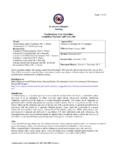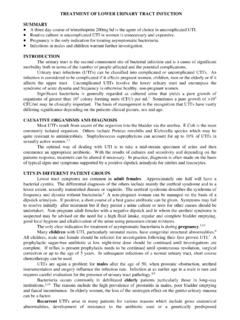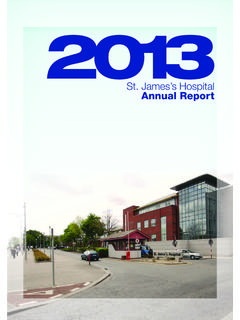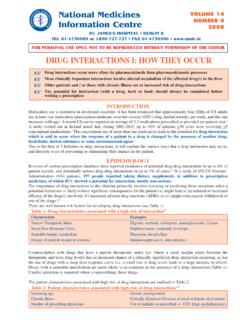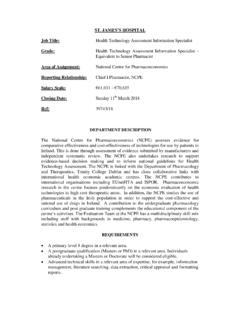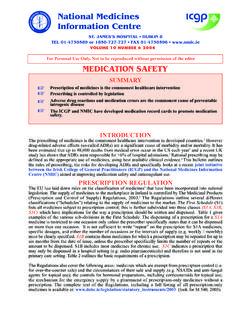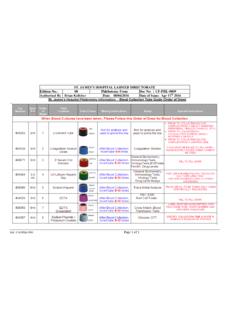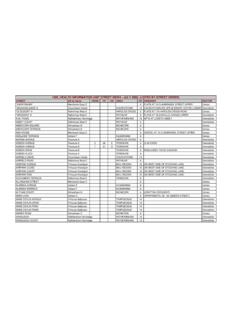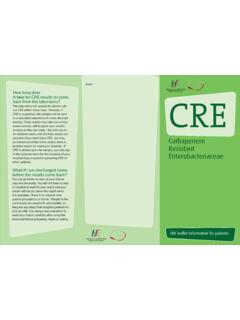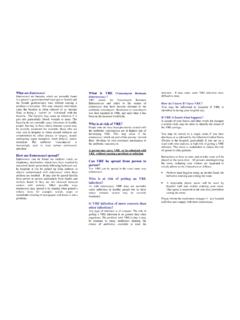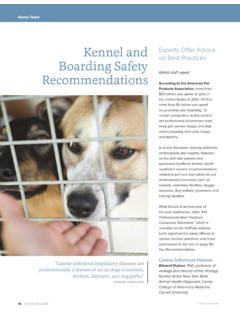Transcription of St James’s Hospital
1 St james s HospitalGeneral Intensive Care and High Dependency UnitsInformation for patients and relativesICU 104/11/2014 13:20 ICU 204/11/2014 13:20 Contents12 The Function of ICU/ HDU Departments a. The General Intensive Care Unit b. The High Dependency Units c. The Patients Bed spaceHow long do patients stay in ICU/ HDU 34 The Team Members5 Patient Information and Confidentiality 6 Telephone Numbers and Location of the Units7 Visiting your Relative8 Infection Prevention and Control Measures 9 Suggestions and Advice 10 After Discharge from ICU or HDU 11 Personal Property12If you are Unhappy with the Care Given/Complaints Procedure13 Donations and Fundraising for the ICU/HDU 14 Useful ContactsIntroduction15 Hospital Facilities for Visitors16 Travelling to and from St james Hospital17 Acknowledgements ICU 304/11/2014 13:204 INTRODUCTIONA patient may be in ICU/HDU because of an accident, an illness or for treatment after a major operation.
2 This can be a worrying time for patients, their relatives and friends. Seeing the patient for the first time can at times be distressing. They are likely to be connected to a number of machines and drips and will often look very different from how they normally look. This booklet has been developed by the ICU/HDU nurses, who recognise the importance of written information to help families through this challenging journey. It is hoped it will support the dialogue between you and the ICU/HDU team who are involved in the delivery of your relatives care. If you require additional information, please do not hesitate to approach any member of the nursing or medical 404/11/2014 13:205 ABOUTTHE FUNCTION OF THE UNITSICU and HDU provide care for critically ill patients with potentially reversible conditions.
3 Patients benefit from intensive monitoring with close observation to complex care involving diagnostic examinations, organ support and treatment. a) The General Intensive Care Unit (ICU) The ICU is a 19 bedded unit. Patients are cared for in either an open plan ward or isolation rooms. The nurse-patient ratio is usually one nurse to one patient. Patients in ICU may be critically ill and require close monitoring and/or specific therapies. Typically ICU patients require support for multiple organs such as the heart, lungs, kidney s with medications and specialist equipment ventilators (breathing support) or dialysis (kidney support). b) The High Dependency Unit (HDU)The HDU (Bennets) has 4 beds and HDU (Duns) has 3 beds, each in open plan wards. The HDU is a less intensive setting compared to the ICU.
4 Many ICU patients will move to HDU when their condition is improving. Typically HDU patients require less support and the nurse-patient ratio is usually one nurse to two patients. ICU 504/11/2014 13:206c) The Patients Bed Space:The bed space consists of an electric bed, specialist mattress/ bed, pumps, monitors and various machines. Every patient is placed on a heart monitor which displays a read out at the bed-side monitor. This monitor continuously displays information such as the heart rate, blood pressure and oxygen levels for patient safety and to help guide our treatment. Infusion and feeding pumps are usually present as patients receive intravenous (IV) medication, fluids or feeding through lines and tubes and may also have various drainage tubes inserted. Some patients may be placed on a machine called a ventilator to support breathing.
5 Patients may find it difficult to communicate either due to sedation or pain control medication, or from the placement of a breathing tube. Each bed space also has a computer used to record the patient s medical and nursing records. ICU 604/11/2014 13:207 HOW LONG?HOW LONG DO PATIENTS STAY IN ICU/HDU:The time patients spend in ICU/HDU will vary depending on their reason for admission, condition and progress. The team continuously re-assesses each patients needs and will update you and your family regularly. If you wish to meet with the ICU/HDU Consultant or Primary Consultant please make request this through the nurse allocated to your relatives care. ICU 704/11/2014 13:208 TEAM MEMBERSTHE ICU/HDU TEAM MEMBERS: The ICU & HDU departments are run jointly with a range of healthcare professionals involved.
6 A medical director with a team of consultants in Anaesthesia & Intensive Care Medicine who manage the care of the patients with a team of doctors in consultation with the primary (admitting) consultant. Directorate Nurse Manager & Clinical Nurse Manager 3 (CNM 3) who assumes overall responsibility for the executive nursing management of the units. Clinical Nurse Managers (CNM). Co-ordinate admissions and patient care. At least one CNM is present on each shift. Staff Nurses; ICU trained nurses assess, monitor and provide all specialist nursing care in both ICU and HDU. Other members of the interdisciplinary team include: A ward clerk, critical care assistants, janitors, radiographers, physiotherapists, speech & language therapists, occupational therapists, pharmacist and clinical nutritionist, medical engineers, information technology, logistics, laboratory, technical services staff, social workers, chaplaincy etc.
7 You may identify staff as follows:PositionUniformClinical Nurse Manager (CNM) Royal Blue/Navy piping ICU Nurse Education Facilitators White/Purple piping Staff NursesLight Blue /Navy PipingCritical Care AssistantsGreyPhysiotherapistsWhite /Navy pipingSpeech & Language TherapistWhite/Red Piping Occupational TherapistWhite/Green pipingAnaesthetic/ICU Medical TeamGreen Theatre ScrubsICU 804/11/2014 13:209 PATIENT INFORMATION AND CONFIDENTIALITYThe ICU/HDU can be dynamic environments with rapidly changing patient conditions and we endeavour to provide timely information on the patient s status. You may phone the units at any time for an update on the condition of your relative. It is helpful to delegate a single family spokesperson who will make the call and pass information onto others to avoid multiple phone calls and increase the time for care of your relative.
8 We respectfully ask relatives to avoid calling at the nurse handover times and if patient privacy and confidentiality reasons only brief information and status updates will be given over the telephone. To protect patients privacy and confidentiality the use of any photography or video equipment within the Hospital is not permitted without prior agreement with a CNM on duty and the consent of the patient. PATIENT INFORMATIONICU 904/11/2014 13:2010 TELEPHONE NUMBERS & LOCATION OF THE UNITSI ntensive Care (ICU) 01 416 2561 /2562. Ask a staff member for the direct access number if in an isolation room. ICU is situated on the first floor past the operating theatres. High Dependency (HDU) (Bennett) 01 416 2345 on the 1st floor just inside the entrance to Edward Halloran Bennett Ward. High Dependency (HDU) (Duns) 01 416 2012/01 428 4042 Situated on the 1st floor at the entrance to Sir Patrick Duns Ward TELEPHONE NUMBERSVISITINGVISITING YOUR RELATIVED o n o t v i s i t i f y o u a r e i l l o r h a v e a n i n f e c t i o n e.
9 G . c o l d , fl u , d i a r r h o e a , v o m i t i n g . If unsure please discuss with the adhere to visiting times: 2pm - 3pm 6pm - 7pmThe CNM can use their discretion in relation to accommodating specific visiting requests outside these ring the bell situated at the entrance to ICU or HDU before entering the units out of respect for patients privacy and your safety. You may use the Hospital phone situated in the ICU visitors waiting area to ring the units if you do not get a response from the 1004/11/2014 13:2011We strive to maximise the time you have with your relative by planning care around visiting times. However when unavoidable, you may be asked to wait if a patient is undergoing an intervention.
10 We ask for your patience as your relatives care and welfare is always our first priority. Please remember Only next of kin and/or immediate significant others should visit. Two persons only may visit the bed space at any one time. Children should not visit unless prearranged in advance with the Clinical Nurse Manager (CNM). Turn off your mobile phone before entering the units. Due to potential electrical inference risk with sensitive medical can you do when visiting?The presence of family and close friends is a very important part of caring for each patient. It helps us to learn more about the patient when they are unable to communicate directly to us. The familiar faces, voices and comforting touch are important positive factors which can aid recovery. When a patient is unconscious or on heavy sedation, nurses and doctors talk to them and explain what they are doing.
